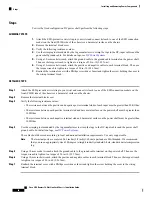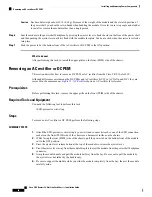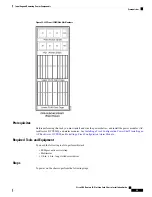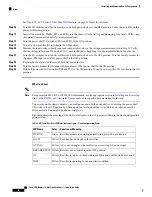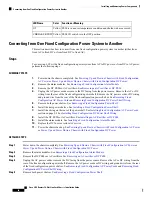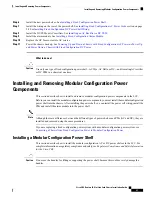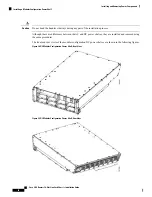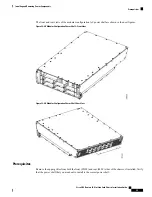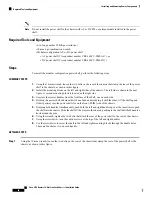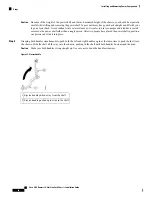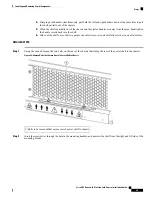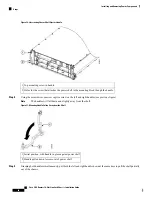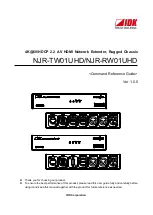
5.
Make sure all boards (RPs, PLIMs, Line Cards, and FCs) are pulled-out and disconnected from the
backplane.
6.
Energize the facility breaker to PEM 0, input 1 on the upper power shelf, PS0.
7.
Measure the voltage at the input terminal block and verify that the DC voltage between the positive and
negative terminals is between 42 VDC and 72 VDC. Make a note of this voltage measurement.
8.
Turn the facility breaker to the OFF position.
9.
Repeat Step 7 and 8 and for each of the remaining five DC inputs on the upper power shelf (PS0).
10.
Repeat Step 7 and 8 for each of the six DC inputs on the lower power shelf (PS1).
11.
Turn the facility power breakers for the upper (PS0) and lower (PS1) power shelf to the ON position.
12.
Turn the upper power shelf (PS0) I/O switch to the ON position. Verify that the “CBREAKER TRIP”
LED on the front panel of each DC PEM is yellow and that no other LEDs are active.
13.
Turn the first PEM (A0) I/O switch on the upper power shelf (PS0) to the ON position. Verify that the
“PWR OK” LED on the DC PEM front panel is green and that no other LEDs are active. Repeat for
the other two PEMs (A1 and A2).
14.
Turn the lower power shelf (PS1) circuit breaker to the ON position. Verify that the “CBREAKER
TRIP” LED on the front panel of each DC PEM is yellow and that no other LEDs are active.
15.
Turn the first PEM (B0) I/O switch on the lower power shelf (PS1) to the ON position. Verify that the
“PWR OK” LED on the DC PEM front panel is green and that no other LEDs are active. Repeat for
the other two PEMs (A1 and A2).
16.
Turn the I/O switches on all PEMs and both power shelves to the OFF position. Verify that no LEDs
on the PEMs are active.
17.
Insert all boards into the chassis (For more information,
Installing and Removing Line Cards, PLIMs,
and Associated Components
chapter).
18.
Turn the power shelf I/O switches (PS0 and PS1) to the ON position.
19.
Turn all DC PEM I/O switches to the ON position.
20.
Measure the input voltage of each input and compare this value to the voltage measurement noted in
Step 7. Verify that the equipment is still receiving the correct input voltage measured in Step 7.
DETAILED STEPS
Step 1
Attach the ESD-preventive wrist strap to your wrist and connect its leash to one of the ESD connection sockets on the
front (PLIM) side of the chassis or a bare metal surface on the chassis.
Step 2
Verify that the safety ground wiring is connected to the upper (PS0) and lower (PS1) power shelves.
Step 3
Make sure that the facility power breakers for the upper (PS0) and lower (PS1) power shelves are in the OFF position.
Step 4
Make sure all the I/O switches are in an OFF position. That is, make sure all power levers are pulled out. There are
total of six power levers for the DC PEMs (one for each of the six DC PEMs) and two power levers for the DC power
shelves (one for each power shelf).
Step 5
Make sure all boards (RPs, PLIMs, Line Cards, and FCs) are pulled-out and disconnected from the backplane.
Step 6
Energize the facility breaker to PEM 0, input 1 on the upper power shelf, PS0.
Make sure that the polarity of the DC input wiring is correct.
Caution
This is a positive ground system; make sure to connect the positive lead to the +RTN terminal and the negative
lead to the –48V terminal.
Caution
Step 7
Measure the voltage at the input terminal block and verify that the DC voltage between the positive and negative
terminals is between 42 VDC and 72 VDC. Make a note of this voltage measurement.
Cisco CRS Routers 16-Slot Line Card Chassis Installation Guide
54
Installing and Removing Power Components
Steps

